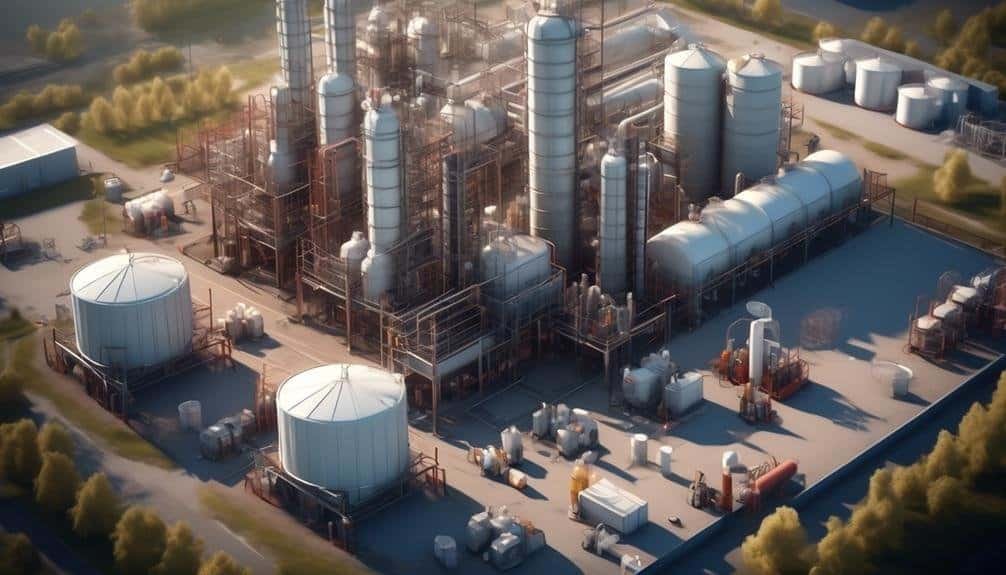The World of Chemical Compliance: Safety and Environmental Concerns
In today's global economy, the management of chemicals is a critical aspect of ensuring both safety and environmental protection. The world of chemical compliance encompasses a complex web of regulations, standards, and best practices that businesses must navigate to ensure the safe handling, use, and disposal of chemical substances.
As the demand for chemicals continues to rise, so do the concerns regarding their impact on human health and the environment. Understanding the intricate balance between safety and environmental concerns in chemical compliance is not only a legal obligation for businesses but also a moral imperative for safeguarding public health and the planet.
Key Takeaways
- Chemical compliance and safety regulations are crucial for safeguarding human health, environmental integrity, and operational sustainability.
- Adherence to personal protective equipment (PPE) requirements and spill response plans ensures the safety and well-being of personnel.
- Proper disposal and waste management of chemicals minimize environmental impact and promote sustainability.
- Compliance automation, training and education, and audits and inspections are essential for efficient and effective compliance management.
Importance of Chemical Compliance
Ensuring compliance with chemical regulations and standards is paramount in safeguarding human health, environmental integrity, and maintaining operational sustainability within industrial and commercial settings. The importance of chemical compliance cannot be overstated, as it directly impacts risk management and cost implications while offering numerous benefits.
Compliance ensures that chemicals are used, stored, and disposed of in a manner that minimizes potential harm to human health and the environment. By adhering to regulations, companies can mitigate the risk of accidents, spills, and other hazardous incidents, ultimately reducing the potential for costly liabilities and legal ramifications.
Moreover, compliance fosters a culture of responsibility, demonstrating a commitment to ethical and sustainable practices. This can enhance the reputation of the organization, leading to increased customer trust and loyalty.
Additionally, compliance often encourages the efficient use of resources, potentially reducing operational costs and waste.
Safety Regulations in Chemical Handling
In the realm of safety regulations in chemical handling, it is imperative to ensure the proper use of personal protective equipment (PPE) and adherence to spill response plans.
PPE requirements dictate the necessary gear to protect workers from exposure to hazardous chemicals, while spill response plans detail the protocols for containing and cleaning up chemical spills to minimize environmental and health risks.
Adhering to these regulations is crucial for maintaining a safe and compliant chemical handling environment.
PPE Requirements
Adhering to strict PPE requirements is paramount in ensuring the safety of personnel involved in the handling of chemicals. The effectiveness of PPE is continuously evaluated and updated to align with regulatory standards.
When it comes to PPE requirements, the following must be considered:
- Protective Clothing: This includes chemical-resistant suits, gloves, and footwear to shield against direct contact with hazardous substances.
- Respiratory Protection: Respirators with appropriate filters or cartridges are essential for preventing inhalation of toxic fumes and airborne particles.
- Eye and Face Protection: Safety goggles or face shields are necessary to safeguard against chemical splashes, vapors, and flying debris.
Compliance with PPE requirements is crucial for mitigating the risks associated with chemical handling and ensuring the well-being of personnel.
Spill Response Plans
Given the critical importance of maintaining safety standards in chemical handling, the implementation of comprehensive spill response plans is imperative for minimizing environmental impact and ensuring the swift containment of hazardous incidents.
Spill response procedures are meticulously designed to address accidental chemical releases, encompassing detailed steps for immediate containment, cleanup, and mitigation of environmental impact. These plans outline the responsibilities of personnel, the utilization of specialized equipment, and the coordination with relevant regulatory authorities.
Effective spill response plans also incorporate measures for the proper disposal of contaminated materials and the restoration of affected areas. Environmental impact mitigation is a key focus, with procedures tailored to the specific characteristics of the chemicals involved and their potential effects on ecosystems.
Regular training, drills, and updates are essential to ensure the readiness and effectiveness of spill response plans in real-world scenarios.
Environmental Impact of Chemicals
The environmental impact of chemicals is a critical consideration in the assessment and regulation of chemical compliance. When evaluating the environmental impact of chemicals, several key factors must be taken into account:
- Chemical disposal and waste management: Proper disposal of chemicals is essential to minimize their environmental impact. This includes adhering to regulations for the safe disposal of hazardous materials and implementing effective waste management practices to prevent pollution and contamination of ecosystems.
- Environmental impact: It is crucial to assess the potential impact of chemicals on the environment, including air, water, and soil quality. Understanding how chemicals interact with the environment allows for the development of effective risk management strategies and the implementation of preventive measures to protect ecosystems.
- Sustainability measures: Incorporating sustainability measures into chemical usage and production processes is essential for reducing environmental impact. This includes utilizing green chemistry principles, promoting the use of renewable resources, and implementing processes that minimize waste generation and energy consumption.
Considering these factors is fundamental in ensuring that chemical usage and production align with environmental sustainability and regulatory requirements. By prioritizing responsible chemical management, organizations can mitigate adverse environmental effects and contribute to a more sustainable future.
Global Standards for Chemical Management
Global standards for chemical management are critical for ensuring regulatory compliance and promoting safety and environmental protection.
International chemical labeling plays a key role in facilitating the safe handling and use of chemicals across borders.
Understanding and adhering to these global standards is essential for organizations to navigate the complex landscape of chemical management and meet their obligations to protect human health and the environment.
Regulatory Compliance Requirements
Ensuring compliance with international chemical management standards is a critical responsibility for companies operating in the global marketplace. Keeping abreast of regulatory updates and implementing industry best practices is essential to meet these requirements effectively.
Companies must adhere to a set of global standards for chemical management, including:
- Classification, Labeling, and Packaging (CLP) Regulation: Ensuring proper classification and labeling of chemicals according to CLP standards.
- Registration, Evaluation, Authorization, and Restriction of Chemicals (REACH): Complying with the strict requirements for the registration, evaluation, authorization, and restriction of chemicals in the European Union.
- Globally Harmonized System of Classification and Labelling of Chemicals (GHS): Adhering to standardized criteria for classifying and labeling chemicals to communicate hazards effectively.
Meeting these regulatory compliance requirements is crucial for ensuring the safety and environmental sustainability of chemical products across international markets.
International Chemical Labeling
Amidst the complex landscape of regulatory compliance for chemical management, the international standards for chemical labeling play a pivotal role in communicating hazards and ensuring the safe handling and use of chemicals across global markets.
International regulations, such as the Globally Harmonized System of Classification and Labelling of Chemicals (GHS), provide a unified framework for chemical hazard communication. GHS standardizes the classification criteria for health, physical, and environmental hazards, as well as the labeling elements on chemical containers, including pictograms, signal words, and hazard and precautionary statements.
This harmonization enhances the understanding of chemical hazards, facilitates international trade, and promotes the protection of human health and the environment.
Adherence to international chemical labeling standards is crucial for businesses operating in multiple countries, as it ensures consistency in communicating chemical hazards and safeguards the well-being of workers and the public.
Compliance Challenges for Businesses
Businesses face numerous compliance challenges in adhering to chemical safety and environmental regulations, requiring comprehensive understanding and meticulous attention to detail. The complexity of risk assessment, especially in the context of global supply chains, presents a significant hurdle for businesses striving to ensure chemical compliance. The following are some of the key compliance challenges faced by businesses:
- Risk Assessment: Conducting thorough risk assessments to identify potential hazards associated with chemicals and their applications is a critical compliance challenge. This involves evaluating factors such as toxicity, flammability, and reactivity, among others, to determine the level of risk and implement appropriate control measures.
- Supply Chain: Managing the compliance of chemicals throughout the supply chain is another daunting task for businesses. Ensuring that all suppliers and partners adhere to the necessary safety and environmental standards, as well as maintaining visibility and control over the movement of chemicals, requires significant resources and coordination.
- Regulatory Changes: Keeping up with the constantly evolving regulatory landscape presents an ongoing compliance challenge. Businesses must continuously monitor and adapt to changes in chemical safety and environmental regulations to avoid non-compliance penalties and reputational damage.
Role of Technology in Compliance
Advancements in technology have significantly impacted the way businesses manage chemical compliance. The use of tech for monitoring and compliance automation has allowed for more efficient and accurate tracking of chemical usage and emissions.
This has not only improved regulatory compliance but also enhanced safety and environmental stewardship within the industry.
Tech for Monitoring
The integration of advanced monitoring technologies plays a crucial role in ensuring chemical compliance with safety and environmental regulations. These technologies encompass a comprehensive suite of capabilities, including:
- Monitoring Technology: Utilizing cutting-edge sensors and monitoring devices to collect real-time data on chemical processes and emissions.
- Data Analysis: Employing advanced algorithms and data analysis techniques to identify patterns, anomalies, and potential compliance issues.
- Predictive Maintenance: Implementing predictive maintenance strategies based on data insights to prevent equipment failures and ensure continuous compliance.
- Remote Monitoring: Leveraging remote monitoring solutions to enable real-time oversight and control of chemical processes, even from off-site locations.
These technological tools not only enhance safety and environmental protection but also streamline compliance management, enabling proactive and efficient adherence to regulatory requirements.
Compliance Automation
With the increasing demand for precision and efficiency in regulatory compliance, technology has become integral in automating processes related to chemical compliance, ensuring adherence to safety and environmental standards. Compliance automation plays a crucial role in facilitating the digital transformation in compliance, streamlining operations, and minimizing the margin for human error. This not only enhances the accuracy and reliability of compliance processes but also contributes to significant time and cost savings.
| Benefits of Compliance Automation | |
|---|---|
| Enhanced Efficiency | |
| Improved Accuracy | |
| Cost Savings | |
| Streamlined Operations |
Training and Education for Compliance
To ensure chemical compliance in the workplace, comprehensive and ongoing training and education programs are essential for employees to understand and adhere to safety and environmental regulations. This includes:
- Online Courses:
- Interactive modules covering various aspects of chemical compliance.
- Accessible anytime, allowing employees to learn at their own pace.
- Offer a wide range of topics, from hazardous material handling to waste management.
Such courses provide a convenient way to ensure that employees are well-versed in the necessary regulatory standards.
- Certification Programs:
- Offer in-depth knowledge and practical skills for compliance.
- Ensure that employees are equipped with the latest regulatory information.
- Provide a formal recognition of compliance expertise, which is beneficial for both the employees and the organization.
Certification programs add a layer of credibility and expertise to the workforce, reinforcing the commitment to compliance.
In today's ever-evolving regulatory landscape, the importance of ongoing training and education cannot be overstated. These programs not only cultivate a culture of compliance but also contribute to the overall safety and environmental sustainability within the workplace.
Compliance Audits and Inspections
Conducting regular compliance audits and inspections is imperative for ensuring adherence to safety and environmental regulations in the workplace. A compliance assessment involves a comprehensive review of all relevant policies, procedures, and practices to ensure that they align with regulatory requirements.
Inspection procedures typically involve thorough examinations of facilities, equipment, and operational processes to identify any potential non-compliance issues. These procedures often include physical inspections, document reviews, and interviews with personnel involved in safety and environmental management.
During compliance audits, trained professionals meticulously examine records and practices to identify any deviations from regulatory standards. Inspection procedures are designed to detect any potential hazards, environmental risks, or safety concerns that may pose a threat to employees, the community, or the environment.
By conducting these audits and inspections, organizations can proactively address any non-compliance issues and take corrective actions to mitigate risks. This not only helps in preventing potential accidents or environmental incidents but also demonstrates a commitment to upholding safety and environmental standards.
Therefore, regular compliance audits and inspections are crucial components of an effective chemical compliance management system.
Emerging Trends in Chemical Compliance
In the realm of chemical compliance, a notable trend is the increasing emphasis on proactive risk assessment and management strategies to address potential safety and environmental concerns. This trend reflects a shift towards a more holistic approach to chemical management, encompassing the entire lifecycle of chemicals from procurement to disposal.
- Chemical inventory: Organizations are placing a greater focus on maintaining accurate and up-to-date chemical inventories. This includes detailed information on the identity of chemicals, quantities stored, location, and associated hazards. Advanced digital tools and platforms are being utilized to streamline the management of chemical inventories, allowing for real-time tracking and monitoring.
- Hazard communication: Enhanced emphasis is being placed on improving hazard communication techniques to ensure that relevant information regarding chemical hazards is effectively conveyed to all stakeholders. This involves the use of standardized labeling, safety data sheets, and training programs to raise awareness and understanding of potential risks associated with specific chemicals.
- Sustainability integration: There is a growing trend towards integrating sustainability considerations into chemical compliance practices. This includes the adoption of greener chemical alternatives, waste reduction strategies, and the implementation of environmentally friendly practices throughout the supply chain.
Future Outlook for Chemical Regulations
The evolving landscape of chemical compliance is poised to shape future regulatory frameworks, guiding the development of more comprehensive and adaptive measures to address emerging safety and environmental concerns. Regulatory changes are expected to be influenced by a variety of factors, including advancements in technology, increased awareness of chemical hazards, and shifting global priorities towards sustainability. Industry adaptation will play a crucial role in shaping the future of chemical regulations, as companies will need to align their practices with evolving standards to ensure compliance and mitigate risks.
One of the key aspects of the future outlook for chemical regulations is the emphasis on proactive risk management. Regulatory frameworks are likely to increasingly focus on preventive measures, encouraging the use of safer chemicals and promoting the adoption of sustainable practices across the supply chain. Additionally, there will be a growing emphasis on transparency and accountability, with regulations aiming to enhance the traceability of chemicals and improve communication of potential risks to stakeholders.
Conclusion
In conclusion, chemical compliance is a critical aspect of ensuring safety and environmental protection in the handling and management of chemicals.
While some may argue that compliance requirements are burdensome for businesses, it is essential to recognize that adherence to regulations is necessary to prevent harm to individuals and the environment.
By prioritizing compliance, businesses can contribute to a safer and more sustainable world for future generations.







